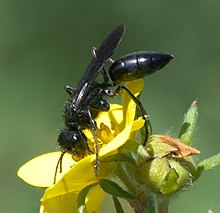Sphecidae
| Sphecidae | |
|---|---|

| |
| Ammophila pubescens | |
| Scientific classification | |
| Domain: | Eukaryota |
| Kingdom: | Animalia |
| Phylum: | Arthropoda |
| Class: | Insecta |
| Order: | Hymenoptera |
| Superfamily: | Apoidea |
| Family: | Sphecidae (Latreille, 1802) |
| Subfamilies | |
|
Chloriontinae Sceliphrinae Sphecinae | |


The Sphecidae are a cosmopolitan family of wasps of the suborder Apocrita that includes sand wasps, mud daubers, and other thread-waisted wasps.
The name Sphecidae was formerly given to a much larger grouping of wasps. This was found to be
Biology
The biology of the Sphecidae, even under the restricted definition, is still fairly diverse; some sceliphrines even display rudimentary forms of
Phylogeny
This
| Apoidea |
| ||||||||||||||||||||||||||||||||||||||||||||||||||||||||||||
Family Sphecidae (sensu stricto)



The old digger wasp family Sphecidae (
Subfamily Ammophilinae
- Ammophila W. Kirby, 1798
- Eremnophila Menke, 1964
- Eremochares Gribodo, 1883
- Hoplammophila de Beaumont, 1960
- Parapsammophila Taschenberg, 1869
- Podalonia Fernald, 1927
Subfamily
- Chlorion Latreille, 1802
Subfamily Sceliphrinae
- Chalybion Dahlbom, 1843
- Dynatus Lepeletier de Saint Fargeau, 1845
- †Hoplisidia Cockerell, 1906
- Penepodium Menke, 1976
- Podium Fabricius, 1804
- †Protosceliphron Antropov, 2014
- Sceliphron Klug, 1801
- Trigonopsis Perty, 1833
Subfamily Sphecinae
- Chilosphex Menke, 1976
- Isodontia Patton, 1880
- Palmodes Kohl, 1890
- Prionyx Vander Linden, 1827
- Sphex Linnaeus, 1758
- Stangeella Menke, 1962
Both of the historical definitions of the Sphecidae (a conservative one, where all the sphecoid wasps other than ampulicids and heterogynaids were in a single large family, and a more refined one, where the seven large sphecid subfamilies were each elevated to family rank) have recently been shown to be
Family Crabronidae
All the other digger wasp taxa that were formerly included in Sphecidae (sensu lato) were placed in the family Crabronidae, which was itself paraphyletic, and recent classifications have split Crabronidae into a number of smaller families, mostly formerly treated as subfamilies.[1]
References
Sources
- Goulet, H., Huber, J.T. (1993) Hymenoptera of the World. Agriculture Canada Research Branch, publication 1894/E. 668pp.
